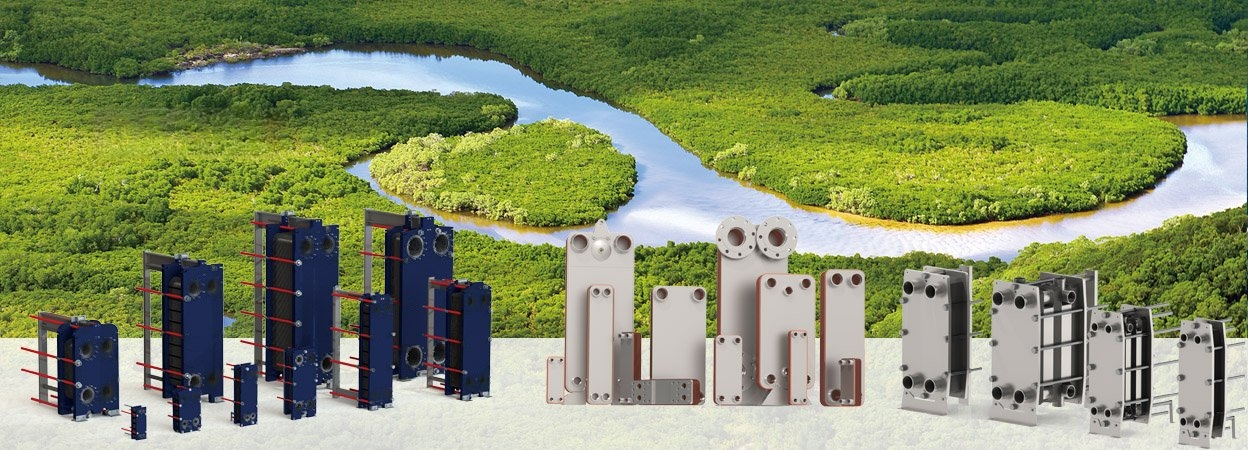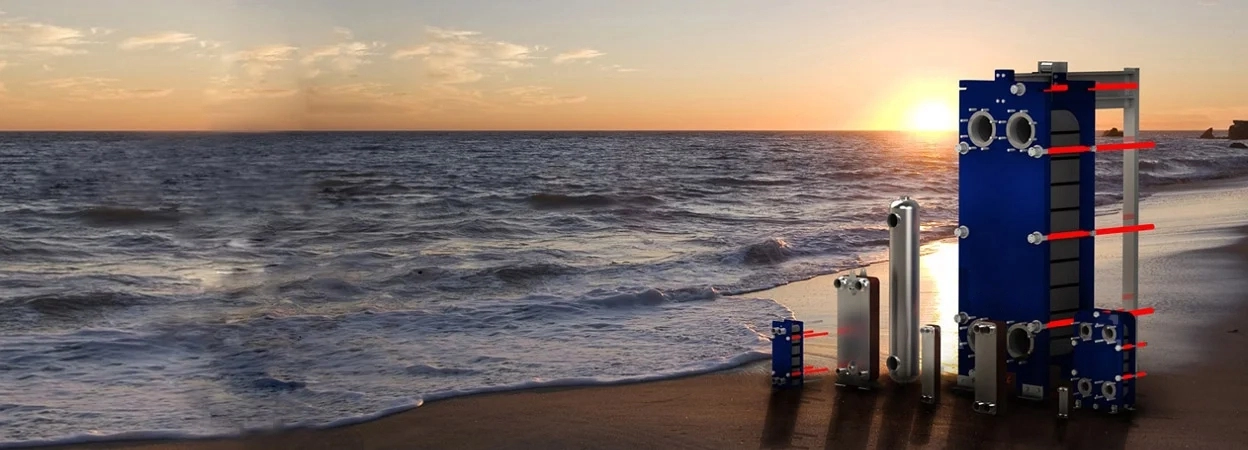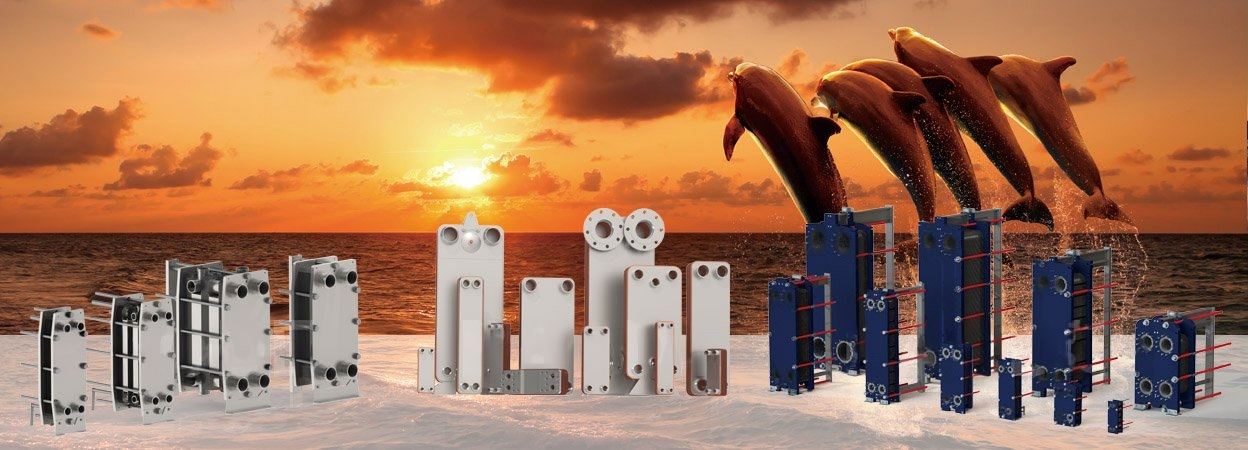Air cross BPHE



AIR CROSS Heat exchanger
Gas-to-liquid plate heat exchanger
Introduction
BAODE AIR CROSS gas-to-liquid heat exchangers are a flexible solution that maximize efficiency while minimizing pressure
drop with gas media.

Applications
• Exhaust gas heat recovery
• Compressed air cooling
• Charge air cooling
• Condenser
Benefits
• Compact
• Easy to install
• Low level of service and maintenance required
• All units are pressure and leak tested
Design
The brazing material seals and holds the plates together at the contact points ensuring optimal heat transfer efficiency and pressure resistance. Using advanced design technologies and extensive verification guarantees the highest performance and longest possible service life.
Asymmetric channels provide optimal efficiency in the most compact design. This results in very low pressure drop on the gas side.
Cross-flow arrangement with open inlets/outlets on the low- pressure side ensures the lowest possible pressure drop when working with gas media.
The Air Cross heat exchanger can be built in modular systems, creating the ability to handle larger gas volume extending the performance efficiency to larger systems.

Technical Data
| Standard materials | |
| Cover plate | Stainless steel |
| Connections | Stainless steel |
| Plates | Stainless steel |
| Brazing filler | Copper / Nickle |
| Dimensions and weight | |
| A measure (mm) | 6 + (3.28 * n) |
| A measure (inches) | 0.24 + (0.13 * n) |
| Weight (kg) | 1.506 + (0.10 * n) |
| Weight (lb) | 3.32 + (0.22 * n) |
| 1 n = number of plates. | |
Standard data
| Volume per channel, litres (gal) | (D2–D4): 0.117 (0.0309) |
| Max. particle size, mm (inch) | 1 (0.039) |
| Flow direction | Parallel |
| Min. number of plates | 20 |
| Max. number of plates | 140 |

The BAODE AIR CROSS gas-to-liquid heat exchanger is an advanced thermal management solution specifically designed to optimize heat exchange between gases and liquids. This type of heat exchanger delivers superior efficiency while maintaining minimal pressure drop, making it ideal for handling gas media in applications where maintaining system performance and energy efficiency is crucial.
AIR CROSS heat exchangers are designed for compactness, easy installation, and minimal maintenance, ensuring long-term operational reliability. Thanks to its brazed construction and asymmetric channel design, the AIR CROSS unit achieves optimal heat transfer with enhanced resistance to high pressures. These heat exchangers can also be modularly configured to meet the demands of larger systems, providing versatile solutions for a wide range of industries.
How the AIR CROSS Heat Exchanger Works
The gas-to-liquid heat exchanger operates on the principle of cross-flow heat transfer, where gas and liquid streams flow perpendicular to each other. The asymmetric channel design ensures that gas flows with minimal resistance, keeping the pressure drop on the gas side as low as possible. This design also enables efficient thermal exchange, even in compact systems.
The heat exchanger is constructed from corrugated stainless-steel plates that create multiple parallel channels. Gas flows through one set of channels, while the liquid passes through the adjacent ones. The brazing material—typically copper or nickel—holds the plates together, ensuring a leak-proof and pressure-resistant unit. This brazed construction eliminates the need for gaskets, resulting in a durable and low-maintenance system.
Applications of AIR CROSS Heat Exchangers
AIR CROSS heat exchangers are ideal for several industrial and commercial applications, including:
- Exhaust Gas Heat Recovery: Recovering waste heat from exhaust gases in industrial processes to improve energy efficiency.
- Compressed Air Cooling: Cooling compressed air in industrial systems, enhancing equipment performance and preventing overheating.
- Charge Air Cooling: Ensuring optimal temperatures for air entering combustion engines, improving engine performance and fuel efficiency.
- Condensers: Using air cross heat exchangers in condensers for cooling and condensing vapors in refrigeration and air conditioning systems.
These versatile applications make AIR CROSS heat exchangers critical in industries like HVAC, automotive, energy production, manufacturing, and chemical processing.
Key Benefits of AIR CROSS Heat Exchangers
Compact Design
The small footprint of the AIR CROSS heat exchanger allows it to fit into tight spaces, making it an excellent solution for applications with limited installation areas.Easy Installation
With all connections on one side and a modular design, AIR CROSS units are easy to install and integrate into existing systems. This feature reduces installation time and costs.Low Maintenance Requirements
The brazed construction minimizes the need for regular maintenance by eliminating gaskets and potential leakage points. This design ensures long service intervals and reduces operational downtime.Leak-Proof Construction
All units undergo rigorous pressure and leak testing during manufacturing, guaranteeing high reliability and durability under demanding conditions.Modular Configuration for Scalability
The modular design of AIR CROSS heat exchangers allows multiple units to be connected, increasing the system’s capacity to handle larger gas volumes while maintaining efficiency.Minimal Pressure Drop on Gas Side
The asymmetric channels and cross-flow arrangement ensure that gas flows smoothly through the system, minimizing pressure drop and maximizing efficiency.
Design and Construction of AIR CROSS Heat Exchangers
The AIR CROSS heat exchanger features several key design elements that enhance performance, durability, and ease of use:
Brazed Construction for Strength and Durability
The plates are brazed together with copper or nickel, creating a leak-proof, pressure-resistant structure. This brazed design not only ensures reliable heat transfer but also eliminates the need for gaskets, reducing the risk of leaks and fouling.Asymmetric Channel Design
The channels on the gas side are larger, which minimizes pressure drop, while the channels on the liquid side are optimized for turbulent flow to maximize heat exchange. This asymmetric design achieves high performance without increasing system resistance.Cross-Flow Arrangement
The gas and liquid streams flow perpendicular to each other, ensuring continuous heat exchange and efficient thermal management.Modular System Configuration
Multiple units can be combined into a modular system to handle higher gas volumes or meet the demands of larger processes. This flexibility allows easy scalability and adaptation to evolving operational requirements.
Materials Used in AIR CROSS Heat Exchangers
The materials used in the construction of the AIR CROSS heat exchanger ensure durability and resistance to corrosion, even in harsh environments:
- Cover Plates: Stainless steel
- Connections: Stainless steel
- Flow Plates: Stainless steel
- Brazing Material: Copper or Nickel
These materials enable the heat exchanger to operate effectively in high-pressure, high-temperature environments and with corrosive fluids, such as seawater or chemical gases.
Why Choose AIR CROSS Heat Exchangers?
The AIR CROSS gas-to-liquid heat exchanger stands out as a reliable, efficient, and cost-effective solution for industries requiring gas-based heat transfer. Here are several reasons why AIR CROSS heat exchangers are the preferred choice:
Energy Efficiency
By recovering waste heat from gases and efficiently transferring it to liquids, AIR CROSS heat exchangers reduce energy consumption and improve system performance.High Performance with Minimal Pressure Drop
The cross-flow design and asymmetric channels allow gas to flow smoothly with minimal resistance, ensuring that the system maintains efficiency without compromising performance.Long Service Life
The stainless-steel construction, combined with brazed joints, ensures that AIR CROSS heat exchangers can withstand demanding operational conditions while providing long-lasting reliability.Adaptable to Changing Needs
Thanks to their modular configuration, AIR CROSS heat exchangers can scale up easily to meet the needs of expanding processes or increased gas volumes.
Conclusion
The BAODE AIR CROSS gas-to-liquid heat exchanger is an innovative solution designed for high-efficiency thermal management across industries like HVAC, automotive, energy, and industrial manufacturing. Its compact size, minimal maintenance needs, and modular design make it ideal for applications where space is limited, and reliability is essential.
With asymmetric channels that optimize performance and cross-flow design to minimize pressure drop, AIR CROSS heat exchangers ensure maximum efficiency in gas-handling applications. Whether used for exhaust gas recovery, compressed air cooling, or condensers, these heat exchangers provide consistent, energy-efficient performance.
By choosing the BAODE AIR CROSS heat exchanger, industries gain access to high-performance thermal solutions that are easy to install, reliable, and cost-effective. If you are looking to optimize your heat exchange processes, AIR CROSS is the ideal choice for seamless integration and enhanced operational efficiency.
